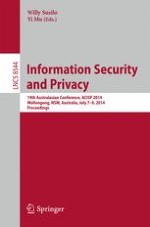2014 | Buch
Information Security and Privacy
19th Australasian Conference, ACISP 2014, Wollongong, NSW, Australia, July 7-9, 2014. Proceedings
herausgegeben von: Willy Susilo, Yi Mu
Verlag: Springer International Publishing
Buchreihe : Lecture Notes in Computer Science
